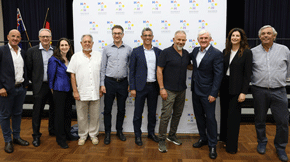Palestine – Remembering the Past to Protect the Future
A telephone poll of a representative sample of 506 Israeli Jews age 15-18 carried out by Maagar Mohot Survey Institute (headed by Professor Yitzchak Katz) for the Committee of Gush Katif Residents between 16-18 January 2011 revealed an appalling lack of knowledge by these teenagers concerning Israel’s evacuation and disengagement from Gaza in 2005.
Hopefully this ignorance can be countered with a visit to the Gush Katif Museum in Jerusalem.
It was my pleasure during a recent visit to Israel to have the privilege of visiting this little known but very important new museum established in 2008 and centrally located at 5 Shaarei Tzedek St Jerusalem just three minutes walk from the Machane Yehuda Market.
The unpretentious and modest exterior of the old building belies the love and dedication of the small band of volunteers who have taken up the challenge to make sure that the ignorance of those 15-18 year olds is addressed.
The Museum explains the rationale for its creation as follows:
“The Gush Katif Museum in Jerusalem is the only museum in the world that unfolds the story of Jewish settlement in the Gaza strip, from the days of the Hasmoneans till the uprooting of Jews during the “disengagement plan” 2005, along with four other Jewish communities in North Shomron.
The years when Jews built settlements in Gaza strip were beautiful. The museum holds a collection of movies and books that deal with this wonderful era, saluting these communities . In the museum the visitor will also find the famous Menorah of Netsarim, which was carried by the settlers to the Kotel (Western Wall) and that became a symbol of the struggle.
The story of this struggle against the disengagement plan is outlined by authentic artifacts, paintings, sculptures, photographs and videos.”
The Museum contains:
• A reference library – housing books about Jewish settlement in Gush Katif and the Disengagement Plan
• An entry hall – presenting the day to day life of Gush Katif and a historical timeline tracing the Jewish presence in the Gaza region for over 3000 years including Kfar Darom between 1948 -1967
• A screening room – depicting films recording the struggle against evacuation
• The Orange Wall – recalling a year and a half of civil struggle to prevent the evacuation
• A memorial room – remembering the fallen residents killed in terrorist attacks and military battles.
• The Black Room – displaying the confrontation between the residents and the Israel Defence Forces and Israeli police officers.
The Museum is open Sunday – Thursday 10.00 – 18.00 and Fridays 9.00 – 13.00 and relies on visitors to supplement its meager finances. The phone number for inquiries is 02- 625 5456. Admission is free but donations and purchase of souvenirs are welcomed
The Museum should be an obligatory visit for
• those 15-18 year old Israeli youth – indeed all school children at least once during their schooling
• bar mitzvah and bat mitzvah tours
• All Israel study missions
As the disastrous effect of such evacuation become increasingly clearer with each passing day, I hope the Museum will extend its treasure trove of information with an additional section covering
• The havoc and destruction subsequently wrought on the 8000 men women and children who were forced to leave
• The political chaos that has descended on Gaza since 2005
• The lessons that must be learned before any further unilateral withdrawals are contemplated by Israel
The Israeli Government was at pains to describe the events of 2005 as
• an “evacuation” not “expulsion”
• a “disengagement” not the ceding of Jewish rights to reconstitute the Jewish National Home in Gush Katif conferred on the Jews by the League of Nations Mandate for Palestine and preserved in article 80 of the United Nations Charter
“Evacuate” is defined in the Collins English Dictionary as:
“to withdraw or cause to withdraw from (a place of danger) to a place of greater safety”
The corollary is that when the danger is removed there can be a return to the place where the removal occurred.
The same dictionary defines “disengage” as:
“To withdraw (forces) from close action”
The corollary is that when the dangers resulting from such close action no longer exist then the disengagement can be reversed.
Jews have had a presence in Gaza at many times over the last 3000 years. It is safe to say they will enjoy a similar privilege sometime in the future.
Meanwhile the Gush Katif Museum will keep the memory and the hopes alive.
Make it a “must see” on your next visit to Israel.
David Singer is a Sydney Lawyer and Foundation Member of the International Analysts Network











